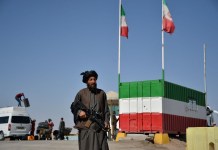Following the painful partition of India in 1947, thousands of people were forced to run for their lives from erstwhile Hindustan to newly created Pakistan and vice versa. Many got killed and many were wounded by the bloodthirsty mobs, which had abruptly emerged from somewhere around our neighbourhoods.
My family was one of the victims of this aching episode. We belonged to Mohanpura, Raja Bazar of Rawalpindi, Pakistan. Yet, after partition, it appeared less homelike, as the threat to our lives continued to hover all the time, with minorities being lynched and raped across the sub-continent.
It would be distantly implausible to think about a nine-month pregnant woman running for life with two minor daughters; to protect them from the filthy gazes and the approach of communal rioters. Fortunately, she had managed to reach a refugee camp in Patiala, where I was born in the freezing winters of November under an open sky. The bitter cold and abject poverty caused new challenges for my parents to save the life of a newly-born in the absence of a proper living place and warm clothes. The inexplicable situation forced them to take shelter at a migrant relatives’ house in Ambala Cantt.
I was dependent on my mother for breastfeeding and other caretaking. So, clinging to her lap was natural. I grew up in poverty; listening to the grumbling and agonising stories all the time. My mother used to curse the time for being unjust to them, as they had lost all the wealth and their palatial house back in Pakistan. My father was a banker and ran a single branch bank, Akal Bank. My mother’s trauma, mental pain and agony post-migration from Rawalpindi to Amritsar greatly affected me.
I lived and grew up in the lap of my mother, who either grumbled or wept over the loss of everything during partition and the migration to a new homeland called India. My parents were citizens of Pakistan for a few days after the creation of the new nation. My mother’s sobs, aches, agony, anguish and sadness, all became a part of my psyche over which my mother did not have control.
Until 2014, there was hardly any religion-based radicalisation in India
I was a witness to terrible fights between mother and father over petty issues. However, most of the times, they encountered each other over poverty and the struggle to revive their lives and bring up five growing children, including two daughters. These rantings and fighting for the mistake of the system grooved deeply within me.
That was my childhood! A time when I was in the dire need of love, affection and warmth of my mother and family. Although it was all there, my mind and psyche were more greatly formed by my mother’s continuous expression of pain and the waves of her arguments with my father over the unending poverty. Many a time, my mother would weep, and I, as a small kid, would tell her, “Chup kar ja, maa,” (Stop crying, mom!).
Sometimes, I would also start weeping with my mother; sharing her pain. This is how I developed into a sensitive, emotional and a non-conformist child. My nature and habits do not match with any of my brothers or sisters. I am a unique child, too sensitive and caring for my parents yet sometimes, fighting with them and revolting against them. I may appear nonchalant, but I have developed all traits of being a non-conformist and anti-establishment (not intentionally, but situationally). I can consider myself a perfect case of being radicalised, but not religiously.
The purpose of sharing this experience has a background. It is linked to the recent statement of the Chief of Defence Staff (CDS), General Bipin Rawat. He said that radicalised youths (girls and boys as young as 10-12) in the Kashmir Valley “need to be taken out separately, possibly into some de-radicalisation camps.”
First of all, the word radical refers to any individual having faith in an extreme ideological fabric irrespective of the subject. Theoretically, personalities like Alter Benjamin, Judith Butler, Theodor Adorno, Martin Luther King, Fidel Castro, Helena Sheehan and Agnes Heller, across the gender and subject, were all termed as radicals at some point.
There is an inherent contradiction with the word radicalisation regarding its use across varying contexts in a loose manner. Among one such case, the term is frequently used by political theorists, governments and security experts to highlight the threat to the national security posed by radicalised individuals.
India was unknown to such terms until 2014. There was hardly any religion-based radicalisation in India. It was used by Western media houses to refer to the radicalisation post 9/11 including the recruitment tactics and hatred induced by radical Islamic militant factions against the Western countries.
The European Union defines radicalisation as the tendency to embrace opinions, views and ideas, which could lead to acts of terrorism. Quite often, the term is interchangeably used with violent extremism to refer to radical right-wing groups. Also, there is a preconceived notion, prevalent among the community of practitioners and academics, that given the right opportunity, the radicalised group or individual, over a period, develops a mindset to participate and justify the acts of violence.
General Rawat’s “off-the-cuff” remarks at Raisina Dialogue in the presence of international dignitaries triggered alarm bells among the saner elements in India and abroad. His statements suggest the local youth is fighting in Kashmir, which the Government of India has been denying; putting the blame on Pakistan for initiating and promoting Kashmir’s struggle for freedom.
Former special secretary in the Cabinet Secretariat and expert on counter-narratives programmes, Vappala Balachandran, contested the claims of Rawat: “India has de-radicalisation camps going on in our country.”
Balachandran claimed that no such camps existed for the police-operated counselling efforts. “I do not know such camps exist in India unless they are secret. If secret, it is alarming.”
He stated that regarding the “camps, I could affirm with my experience of studying, writing and lecturing on the ‘counter-narratives’ programme for over 15 years, especially to the Maharashtra police and Karnataka government, that no such ‘camps’ exist for the police-operated counselling efforts.”
However, even if we take the statement of General Rawat seriously, a question arises that what did he propose to deal with over 8 to 9 lakh children in the age group of 10 to 12 years in Kashmir Valley. Although the J&K police, under the aegis of the government, had already carried such de-radicalisation processes, it had not involved the entire children community.
It has been observed that the instances of young Kashmiris joining militant outfits are on the rise; forcing Jammu and Kashmir police to launch a counter-strategy of bucking the trend by holding what is termed as a “deradicalization” drive.
Social networking sites are on the scanner of the security agencies, which keep a tab on the activities of youngsters on the Internet. The effort seems to have worked as the state police claims to have successfully brought 20 boys back in the mainstream through intensive counselling. These youngsters had shown the inclination to join militancy but were apprehended before they took up guns and made to lead a normal life.
Latest estimates show that over 60 per cent of the militants active in the valley are locals. Out of the 142 militants operating in the conflict-hit state, 88 are Indians. The indigenous Hizbul Mujahideen has replaced Lashkar-e-Taiba as the number one terror outfit in the Valley. Intelligence agencies are keeping an eye on families with young boys who could be vulnerable to join the terrorist outfits.
“After identifying youth who are potential recruits, we are reaching out to their families trying to convince them that their children should not join militant groups. After counselling the boys, we have managed to de-radicalise quite a few,” the home ministry official informed Indian Express.
The former inspector general of Jammu and Kashmir Police for North Kashmir has, on record, maintained that the focus was on de-radicalisation in north Kashmir and that their job had become easier due to support from parents and guardians of these boys.
This is how radicalisation feelings could be stemmed out, not through what General Bipin Rawat claimed. The General must understand that it is the apathetic approach of the successive governments, which has given a lease to radicalisation in Kashmir Valley.
The Indian government, since the start of armed insurgency in 1990, has provided every possible opportunity to vulnerable children in conflict to get inflicted by the worms of radicalisation. The government pursued wrong policies viz-a-viz maintaining peace and calm in the Kashmir. Children born in the past three decades have become naturalised to the conflict and radicalisation, intentionally or unintentionally. The biggest factor for which is that the government did not let them vent out frustration.
Intermittent curfews, internet shutdown and even clampdown on movement forced children to spend more time with the people who had witnessed atrocities in the early 1990s. When parents at home talk about atrocities, the subconscious mind of children capture it and develop a negative image of the nation. In the last 30 years, children have been subjected to unwarranted and unprecedented shutdowns.
They have become witnesses to a bloodbath and manipulated narratives of Azadi, so their derailing from the mainstream is natural. We have seen that in the recent past, children, including girls, are participating in stone-pelting. In such a situation, you cannot imagine segregating and alienating children from their parents as it will further escalate the feeling of alienation. The government should provide open space to the youth of Kashmir, wherein they should not fall prey to narratives that can trigger radical thoughts.
There’s a difference between counter-radicalisation and de-radicalisation that vary significantly with scenarios, approaches and policy initiatives. Counter-radicalisation is an aggressive measure employed by the state to target a specific community to minimise the risk from the breeding of radical individuals. Initiatives often involve daily engagements between the target community and the police, including the distribution of counter-radical information campaign.
India Used Israeli Spyware To Target Top Pakistani Officials, Diplomats
On the contrary, de-radicalisation is a reactionary measure employed by the state to alter the ideology of radicalisation induced by an individual. Policymakers must understand that the de-radicalisation approach is employed in a security-driven ecosystem, whereas the counter-radicalisation approach is employed for the overall development of the community, region, society and political dynamics. In short, counter-radicalisation is a superset of de-radicalisation.
Thus, instead of going for large-scale throwing of children into deradicalisation camps, the government must focus on case-wise counselling, besides providing an open platform to discuss issues so that children must not feel alienated from the system. In the beginning, I shared my experience only to state that it is not necessary that external forces influence one’s thought process. Sometimes, the subconscious mind also picks up things that are unacceptable in society.
Chanchal Manohar Singh is a senior journalist and an Indo-Pak peace activist




